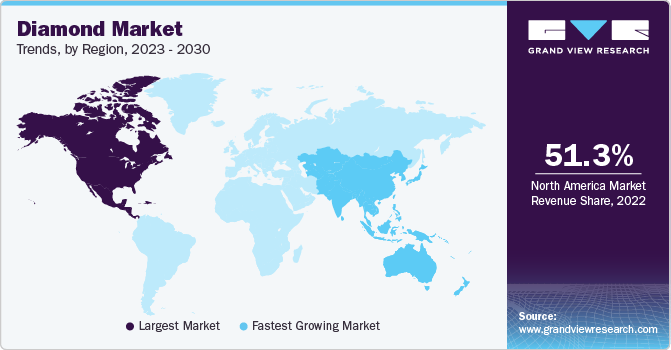Diamond Industry Overview
The global Diamond Market, valued at USD 41.49 billion in 2024, is projected to achieve a CAGR of 3.3% from 2025 to 2030. This growth is largely fueled by the increasing appetite for jewelry, especially within the rapidly growing economies of China and India. The diamond industry operates through a value chain that includes upstream activities (rough diamond exploration, production, and sorting), midstream processes (cutting and polishing), and downstream operations (jewelry design, setting, and retail sales).

In 2024, the Asia Pacific region emerged as the second most significant market for diamonds after North America. The strong purchasing power of millennials in this area is a primary factor driving the growth of the diamond jewelry market, signaling significant untapped potential for market development. Acknowledging this considerable potential within the Asia Pacific, existing players in the diamond industry are actively seeking to increase their investments and broaden their reach to a larger audience.
Detailed Segmentation:
- Price Trend Insights
Diamond prices have remained volatile into 2024, influenced by factors like inflation, currency fluctuations, and shifting consumer preferences. After a rebound in 2023, diamond prices rose in the year's first half, driven by strong demand, but softened in the latter half due to economic uncertainties. In 2024, the market stabilizes but remains sensitive to global economic conditions, the rise of synthetic diamonds, and changing buying patterns. Manufacturers face pressure to adapt to these trends, with companies like Henan Huanghe Whirlwind and Sino-Crystal expanding into jewelry to capitalize on the growing demand for affordable and sustainable options.
- Type Insights
The synthetic diamond segment is projected to grow at the fastest compound annual growth rate (CAGR) in the coming years, driven by advancements in production techniques like High-Pressure, High-Temperature (HPHT), and Chemical Vapor Deposition (CVD). These diamonds, primarily used for industrial applications such as cutting, drilling, and abrasives, have seen increasing adoption in the jewelry market due to significant reductions in production costs. Acceptance of synthetic diamonds in jewelry applications among millennials is gaining prominence in many countries. In addition, synthetic diamonds generally cost 30% to 40 % less than mined diamonds, which gives them a competitive edge over natural diamonds.
- Application Insights
The growing middle-class population, coupled with the increasing spending power of millennials and Gen Z, are key factors contributing to the growth of this segment. As per De Beers Group, millennials represent almost 60% of the U.S. jewelry market, while millennials in China drive 80% of the total national demand for jewelry. Millennials tend to spend extra on travel experiences rather than luxury items. Thus, manufacturers and retailers are now actively considering the idea of attaching a story in their marketing campaigns that includes the lifecycle of a diamond from the mine to consumers.
- Regional Insights
North America diamond market held over 51% revenue share of the global market. Ascending product demand for industrial applications is a key factor contributing to synthetic diamond penetration in this region. Under industrial application, the major sectors include machinery manufacturing, construction, and mining services (drilling and exploration for natural gas, oil, and minerals). Buildings, highways, stone cutting, and repair applications accounted for a majority of the consumption of synthetic diamonds for industrial purposes.
Gather more insights about the market drivers, restraints, and growth of the Diamond Market
Key Companies & Market Share Insights
Some key players operating in the market include Petra Diamonds Limited and Rio Tinto.
- Petra Diamonds Limited is a UK-based diamond mining company focusing on extracting high-quality diamonds from its operations in southern Africa. The company primarily operates several mines in South Africa and Tanzania, including the Cullinan mine, known for producing some of the world’s most famous and valuable diamonds.
- Rio Tinto is a major multinational mining corporation with significant operations in the diamond industry, most notably through its ownership of the Argyle and Diavik mines. The company is known for its vertically integrated approach, encompassing exploration, mining, and the sale of rough diamonds. While Rio Tinto’s diamond production has consistently contributed to its overall revenue, it has made strategic moves in recent years to scale back its diamond operations, including the closure of the Argyle mine in 2020 due to declining reserves and economic factors.
Key Diamond Companies:
The following are the leading companies in the diamond market. These companies collectively hold the largest market share and dictate industry trends.
- Petra Diamonds Limited
- Rio Tinto
- Trans Hex Group
- Lucara Diamond
- ALROSA
- De Beers
- Mountain Province Diamonds
- Arctic Canadian Diamond Company
- Gem Diamonds
Order a free sample PDF of the Market Intelligence Study, published by Grand View Research.
Recent Developments
- In July 2023, Burgundy Diamond Mines Limited, a diamond mining firm, completed the acquisition of Arctic Canadian Diamond Company (ACDC). ACDC owns the Ekati mine in the Northwest Territories region of Canada. The move is expected to help Burgundy Diamond Mines in its strategy of vertical integration across the diamond value chain
- In July 2023, De Beers Group entered into an agreement with the Botswana government to increase the number of rough stones provided to the African nation. The plan is intended to enhance the capacity of the company’s facility and increase the number of rough stones by 50 percent over the next decade
- In May 2023, Blackstone Inc., one of the world’s largest alternative asset management companies, announced the diamond grading firm International Gemological Institute (IGI) acquisition for USD 535 million. The acquisition is a significant milestone in Blackstone’s expansion plans in India.


No comments:
Post a Comment